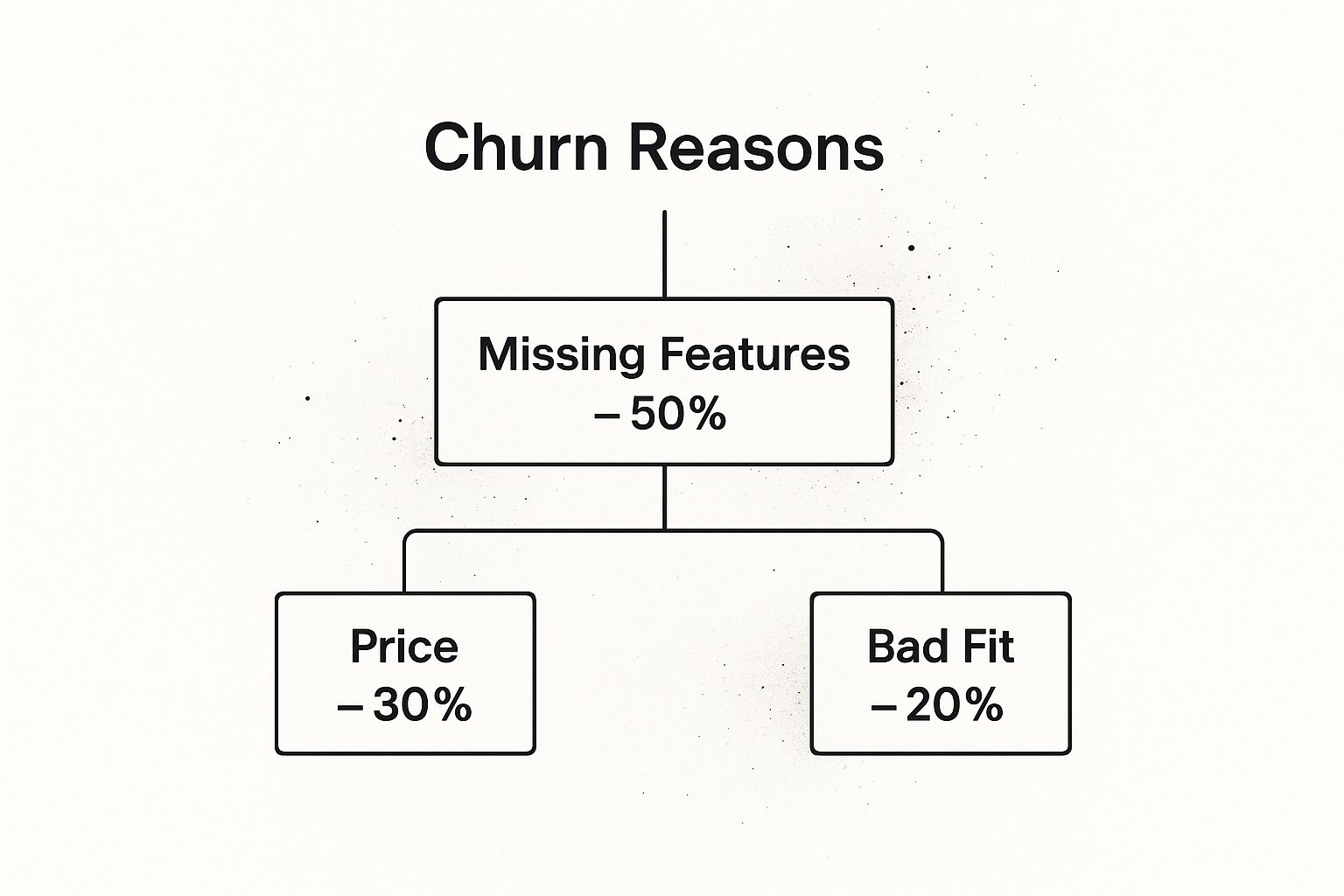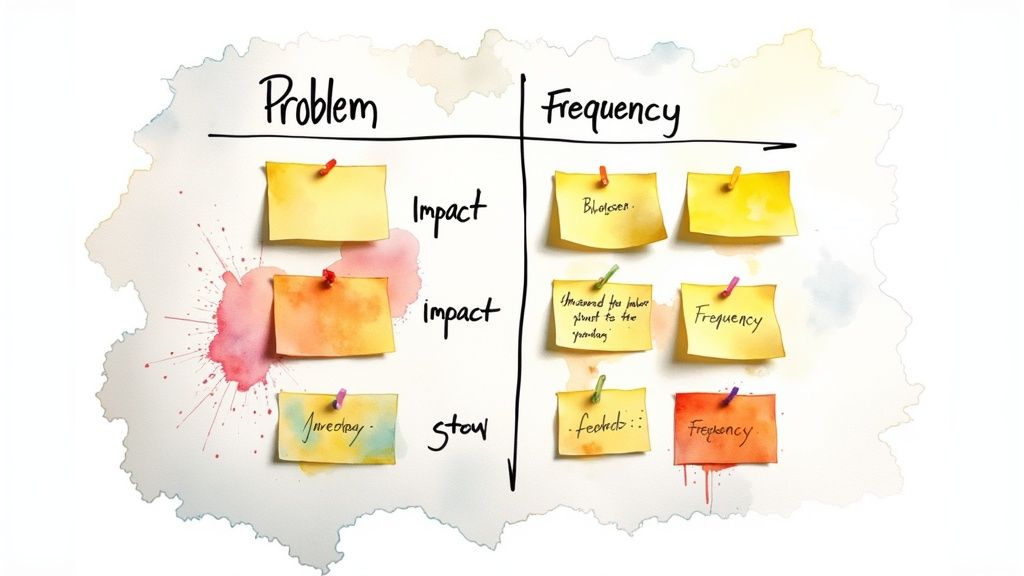Your Customer Feedback Is Lying To You. Here’s How to Find the Truth.
Stop guessing. Uncover raw, unfiltered customer feedback insights that actually grow your startup. No fluff, just founder-to-founder truth on what works.
Posted by
Related reading
Your Customers Are Telling You How to Beat Your Competitors, but You're Not Listening
What is text analytics? A blunt guide for founders on turning messy customer feedback into a data-driven roadmap for growth and revenue.
Your Customers Are Screaming at You. Are You Even Listening?
Discover the sentiment analysis techniques that turn customer feedback into a competitive advantage. A practical, no-fluff guide for founders.
Your Survey Data Analysis is a Waste of Time
Stop guessing and start growing. This guide to survey data analysis cuts the fluff and reveals the unfiltered methods that drive real startup growth.
You think you're listening to customers. You’re not. You’re listening to the 5% who love you enough to fill out a survey, creating a dangerous echo chamber while the silent majority just cancels and disappears. Your “data-driven” approach is a vanity project, and it’s going to kill your startup.
This isn’t about “the importance of listening.” This is about survival. Ignore what your customers are really saying in their support tickets and cancellation notes, and you’ll be lucky to survive the quarter.
Your 'Data-Driven' Approach Is A Lie
Let’s be honest. You send a Net Promoter Score survey once a quarter and call yourself “data-driven.” You’re not. You’re collecting high-fives from your fans while your churn rate—the only metric that can’t lie—is telling you a story you’re too scared to read.
You’re drowning in noise—clicks, session times, CSAT scores—that tells you what is happening but never why. True customer feedback insights are the signal in that noise. They’re the raw, painful comments that connect the dots between a plunging metric and a shitty user experience. Your product roadmap should be a direct response to your customers' biggest frustrations. If it’s not, you’re just building your ego.
Forget Vanity Metrics, Hunt for Pain
Stop celebrating your 9/10 NPS scores. They’re worthless. The gold is in the 6/10 scores and, more importantly, the brutal comments they leave behind. It’s in the support ticket tagged "confusing" for the third time this week. It’s in the cancellation survey where a user writes, "Your onboarding is a nightmare." These aren't data points; they're open wounds in your customer experience.
- Vanity Metric: An 85% CSAT Score.
- Actionable Insight: "I was satisfied, but it took me 20 minutes to figure out how to export my data, which should have been one click."
One lets you sleep at night. The other gives you a high-impact fix that prevents future churn. Stop getting high on the sugar rush of positive feedback and develop a taste for the bitter medicine of criticism—that’s where growth lives. If you need to deprogram your corporate brain, this guide on https://backsy.ai/blog/what-is-data-driven-decision-making cuts through the usual BS.
Takeaway: Your survival depends on fixing the most painful parts of your customer experience, not collecting happy numbers for a slide deck.
Your Support Inbox Is a Goldmine You’re Ignoring
Your support inbox is not a cost center; it's a real-time report of every promise your product has broken. Treating it as a fire to be put out by a junior team member is a catastrophic mistake. Every ticket is a detailed account of a confusing feature, a broken workflow, or a moment of pure frustration.
Ignoring this is like finding a leak in your boat and choosing to bail water instead of plugging the damn hole. You’re not just fixing one-off complaints; you're performing an autopsy on a failed user experience. The support ticket is the cause of death. Your job is to make sure it doesn’t happen again.

Takeaway: Your support queue isn’t a list of problems to solve; it's a diagnostic report on your product's failures.
Turn Angry Rants into Hard Numbers
"But it's all qualitative!" I hear you whining. "How do I turn angry emails into something my product team can use?" You stop treating them like emails and start treating them like data. The weapon is tagging. Not status tags, but pain tags.
#ui-confusion: "I can't find the button."#billing-error: "Why was I charged for this?"#bug-critical: "This is broken and I can't do my job."#feature-request-export: "I need to get my data out."
Suddenly, you’re not dealing with anecdotes. You’re walking into the product meeting saying, "We had 47 tickets last month tagged #ui-confusion about the new dashboard." That’s a number your PM can’t ignore. It's the first step to learning how to analyze qualitative data like a weapon.
This isn't trivial. Research from Webex.com shows 70% of customers ditch a brand after just two bad experiences. Ignoring these patterns is choosing to bleed out.
The "Silent Scream" Metric
Here's the terrifying part: for every customer who bothers to write a support ticket, dozens more hit the same wall, say "screw this," and churn in silence. Your support tickets are the tip of a very large, very dangerous iceberg. If ten people complained about a broken feature, you can bet a hundred others just left.
Think of each ticket not as one user's problem, but as a proxy for the dozens you never heard from. This isn’t just about collecting customer feedback insights; it’s about respecting the effort a user took to tell you something was broken.
Takeaway: A support ticket isn’t one person’s problem; it’s evidence of a systemic failure that’s quietly killing your growth.
The Brutal Honesty of People Who Are Leaving You
Nobody tells you the truth like someone who's already walking out the door. A customer canceling their subscription is the ultimate feedback—they are voting with their wallet, and you lost. Yet, most founders screw this up with a generic, multiple-choice survey that gathers zero insight.
"Price" is not the reason they left. It’s the easy excuse. The real reason is your product wasn't valuable enough for what you charged. That’s a product problem, not a pricing problem.

The Exit Interview Is an Autopsy, Not a Sales Pitch
Your cancellation flow has one job: learn why they’re leaving so you don't lose the next hundred customers for the same reason. This isn't your last-ditch effort to win them back with a cheesy 20% discount. It's an autopsy. You're the coroner. Your goal is to determine the cause of death.
Stop with the multiple-choice bullshit. Ask one, open-ended question:
"What's the primary reason you're canceling?"
Then shut up and listen. The answers will be raw, uncomfortable, and worth more than a thousand NPS surveys.
Fixable vs. Fatal
Every piece of cancellation feedback falls into one of two buckets. Don't overcomplicate it.
- Fixable Product Gaps: Gold. Missing features, critical bugs, a nightmare onboarding. This is your product roadmap, handed to you by the people you failed.
- Unfixable Bad-Fit Customers: The people you never should have sold to. Their business is too small, too big, or they need a completely different solution. You can't fix this. Don't try.
Separating these two is everything. Fixing product gaps for your ideal customers builds a moat around your business. Building for bad-fit customers creates a Frankenstein product that serves no one. For more, our guide on how to reduce customer churn shows you the strategic levers to pull.
Takeaway: Your cancellation survey isn't a final sales attempt; it's the most brutally honest consultation you’ll ever get, and it's free.
How to Turn a Pile of Complaints into a Product Roadmap
So, you have 500 rows of user complaints in a spreadsheet. Great. This is where most founders get stuck. They admire the data, feel overwhelmed, and then let it die a slow death in a forgotten Google Sheet. A pile of feedback is useless. A set of customer feedback insights that dictates your next move is priceless.

Your mission is not to build every feature someone asks for. That’s how you build a bloated mess. Your mission is to find the themes—the underlying problems—that stop the bleeding.
Takeaway: Raw feedback is a liability; synthesized insights are a weapon.
The Founder's PIF Matrix: No-BS Prioritization
Forget complicated frameworks. You need something simple and brutal. I call it the Problem, Impact, Frequency (PIF) Matrix. It forces you to quantify the unquantifiable.
For every feedback theme (e.g., "export is clunky"), score it:
- Problem: What's the actual issue? A bug, a missing feature, a UI dead end? Be specific.
- Impact: How bad is the pain? Score 1-5 (1 = trivial, 5 = causes churn).
- Frequency: How many distinct users are hitting this wall?
Multiply Impact x Frequency. The highest scores are your roadmap. Simple. You’re no longer guessing; you’re using your customers' pain as a compass.
Takeaway: Don't build what's popular; build what fixes the most painful, most frequent problems.
Manual Hell vs. Automated Sanity
You can do this manually. I did. It’s a soul-crushing grind in a spreadsheet. It forces you to feel your customers' pain in your bones. But at some point, you have to choose: are you in the business of running a spreadsheet or building a product?
| Analysis Method | What It Really Means | When to Use It | The Brutal Reality |
|---|---|---|---|
| Manual Tagging | Living in spreadsheets, mainlining coffee. You or an intern read and tag everything. | When you have fewer than 50 feedback items a month and more time than money. | Incredibly slow, biased, and doesn't scale. A total time-suck. |
| AI-Powered Automation (like Backsy.ai) | Software reads, understands, and tags all your feedback automatically. You just review the insights. | The second you feel like you're drowning. When you need to move fast. | Frees up your time to act on insights instead of just collecting them. It's your unfair advantage. |
Acting on insights is what builds loyalty, yet a shocking 48% of companies don’t even bother to close the loop with dissatisfied customers, according to Medallia's research on customer loyalty. That gap is your opportunity.
Takeaway: Your first hire for analyzing customer feedback insights should be software.
Stop Chasing Satisfaction. Build Loyalty.
Let's be blunt: "customer satisfaction" is a vanity metric. It’s a participation trophy. A satisfied customer isn't a loyal one. Satisfaction is the bare minimum required to stay in business, a fragile truce that can be broken by a competitor's shiny new feature. Chasing a perfect CSAT score is like trying to fill a leaky bucket—you’re ignoring the hole that's slowly draining your business.
Takeaway: Satisfaction is transactional. Loyalty is relational.
Loyalty is Forged When Things Go Wrong
Real loyalty isn’t created when things go right. It’s forged in the fire when everything falls apart. It’s what happens when your server goes down, and your team fixes it before the customer’s day even starts. A customer who has a problem solved quickly and effectively becomes more loyal than one who never had an issue. They’ve seen you handle a crisis. They trust you.
Stop asking if your customers are happy. Start figuring out if they trust you enough to come back after you’ve messed up.
According to new customer loyalty trends from Qualtrics.com, a staggering 99% of consumers now say customer service is a make-or-break factor. Your "satisfied" customers are just waiting for a better option.
Takeaway: A satisfied customer will leave you for a better price; a loyal customer will forgive you for a mistake.
Stop Analyzing and Start Shipping
You’ve done the work. You found the signals. You presented them in a meeting. Everyone nodded. Then... crickets. This is where 99% of companies fail. They confuse analysis with progress. The work isn’t finding the insight; it’s acting on it.
Takeaway: Insights don't improve products. Shipping code and talking to customers do.
Close the F*cking Loop
The worst thing you can do is ask for feedback and then ignore it. It’s a slap in the face. Closing the loop isn't a "Thanks for your feedback!" auto-reply. It's taking action and then personally telling the customer what you did because of what they said.
"Hey Jane, you told us our export feature was a nightmare. You were right. We just shipped a fix, and your feedback was the reason why. Check it out."
That one email builds more loyalty than a thousand marketing campaigns. It turns a frustrated user into a fan because you proved you actually listen.
A Playbook That Actually Works
- Integrate Your Tools: An insight must become a Jira ticket or a Trello card in one click. Stop copy-pasting like an intern.
- Assign Ownership: Every piece of feedback needs an owner. No owner, no action.
- Communicate Back: When the fix ships, the owner tells the customer. This is non-negotiable.
This isn’t just process; it’s the difference between a business that listens and one that wins.
Takeaway: Close the loop with every customer, every time, or watch them walk to a competitor who will.
No-BS FAQ
Cut the fluff. Here are the real answers.
Is AI Feedback Analysis Just Guesswork?
No. It’s pattern recognition at a scale a human can't match. It’s not reading minds; it’s flagging keywords like ‘broken,’ ‘confusing,’ or ‘slow’ across thousands of comments. The AI finds the fire; your job is to put it out. It’s math, not magic.
How Do I Start a VoC Program with No Team?
You don’t. "Programs" are for corporations. You build a habit. Set aside 30 minutes every Friday to read raw support tickets and cancellation notes. Just read. Get a feel for the pain. Once the volume is overwhelming, get a tool. The goal isn't a perfect program; it's to feel your customer's pain so viscerally you have no choice but to fix it. If you need a starting point, check out these proven methods for collecting valuable customer feedback.
What About "Squeaky Wheel" Customers?
This is why the ‘Frequency’ score in the PIF matrix is your best friend. One loud customer is an anecdote. Ten quiet customers with the same problem is a pattern. Thank the squeaky wheel, log their feedback, but don't let a single loud voice derail your roadmap. Data keeps you disciplined.
Stop drowning in spreadsheets and start shipping fixes your customers will pay you for with Backsy.